Maroon
With income from his position as Postmaster-General, TLM-P was able once again to afford a grazing property. The earliest mention found is 20 September 1864 when he recorded a muster of cattle there (as well as on Coohin and Head of Logan - indicating the lack of fences and intermingling of branded cattle).1) The muster was apparently satisfactory because, in November 1864, LM-P agreed to buy the 20,000-acre Melcombe, close to his old station of Bromelton. In March 1865, TLM-P signed a memo of agreement with the Bank of Australasia for the purchase of Melcombe (renamed Maroon) for £3,000 and Heads of Logan (renamed Rathdowney) for £1,200. A loose note in with TLM-P's 1880s diaries and in his handwriting, states that on 3 March 1865 he 'Left to inspect Maroon at the Head of the Logan - via Tamrookum'. On 11 March 1865, he returned to Brisbane and either on that date or the 17th he 'closed with bank for Maroon £4200'.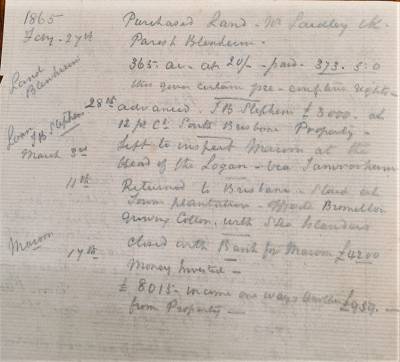 . In May 1866, he paid £40 in legal expenses for the purchase of Maroon.
. In May 1866, he paid £40 in legal expenses for the purchase of Maroon.
Maroon would be home to four generations of Murray-Priors over 54 years.
Angella Collyer describes Melcombe in 1867 as having 60 square miles available for pasture improvement; 16 square miles unavailable, “PP nil'. The Heads of Logan property had 20 square miles available; 16 square miles unavailable; PP nil. In 1869 he consolidated the two as 'one large property of 100 square miles' then in 1874 he separated them again, calling one property of 54 square miles Melcombe/Maroon and the other Palen. It is unsure, she states, if Palen and Heads of Logan had the same boundaries.2) Deb Stenzel indicates that, in November 1868, TLM-P had pre-emptively selected his Homestead Blocks of 2,560 acres. She explains that, under the Imperial Waste Lands Occupation Act, enforced from 1847, squatters had 'pre-emptive purchasing rights (ie. the ability to buy the land as freehold, before it was resumed by the government and offered for general sale).3)
Maroon is in the Logan district, south-west Queensland. Mt Lindesay was on Maroon's south boundary. It was country belonging to the Yuggerabul (or Yugarapul or Ugarapul) Indigenous group.4) Evidence of a rock shelter dates their occupation at least back to 1300 BC.5) By 1864 the indigenous owners had been dispossessed and largely decimated though 'tension' continued until the 1880s.6) Originally, the property name was spelt Marroon. There are conflicting beliefs about the name's derivation. The Wiki entry for Maroon states it was derived from wahlmoorum, which is the Yaggera language name for Mount Ballow, associated with a legendary giant sand goanna.7) Deb Stenzel states that it derives from the Aboriginal name for Mt Maroon - 'murran'.8)
Rosa Praed described Maroon in a number of her books, including as the Doondi station in her novel The Head Station.9) Rosa also reminisced about Maroon in a letter to her stepsister Dorothy, 'the view from the Maroon verandah - the old racecourse and paddock and the river with its still deep pools', but also noted that, when she last visited the property in 1893, 'it had all greatly changed'.10) Maroon had rich river flats but in its outer reaches 'the imposing Mounts Maroon, Barney, Ballow and Clunie overlooked wild, thickly timbered rainforest, rocky gorges and ravines, crater lakes, waterfalls, and rugged scrub country.'11) Deb Stenzel, a local resident who is an expert in the area's history, notes that (from her study of the original survey documents included in the Selection files in the Qld Archives) that most of the land fairly close to the homestead was quite open forest country, and not the dense vine scrubs that covered other parts of the district (including a fair bit of the original Maroon run). The geology also indicates that it supported open forest country. Most of the early pastoral run homesteads were built in more open country … - less trees to be cleared, allowing easy grazing for sheep and cattle.12)
The following map from Collin Pfeffer's well-researched The Fassifern Story shows Maroon and adjoining properties. 13) Proximity did not necessarily mean easy access. Deb Stenzel, for example, points out that the boundary between Maroon and Coochin Coochin was a ridgeway.
13) Proximity did not necessarily mean easy access. Deb Stenzel, for example, points out that the boundary between Maroon and Coochin Coochin was a ridgeway.
When TLM-P bought Maroon, the area was sparsely settled. Rosa Praed wrote that the family went via Ipswich (then the nearest town), and had to hack their way through the Dugandan Scrub to reach their new home.14): 'It used to take a whole day getting through the Dugandine Scrub, for though its width was not great, progress was extremely slow. A boy had to go in front with his tomahawk to chop away vines and remove logs; and sometimes a huge tree would have fallen, which necessitated camping a while and clearing a fresh track round it … We children would walk on each side of the buggy ready with large sticks or stones to prop the wheels when the horses jibbedm… The scrub was something like an Indian jungle, only less dense. Here, where the sun never penetrated, the rich soil and decaying vegetation gave out an earthly and unforgettable smell. The trees had glossy leaves, and mostly bore berries - some poisonous, others like the chucky-chuckles and purple plum wholesome and delicious.”[Rathdowney display - from My Austn Girlhood?] Later Rosa would mourn how the scrub had been cleared: 'The scrub is gone - the lovely,beautiful scrub, which can never be made again. One cannot now hear the dingoes howling and the melancholy note of the morepork[check] nor the faint crying of the native bear. Instead of the long gum stretches there are patches of maize and millet.'15)
Deb Stenzel explains just how difficult it was to get to and from Maroon: 'To reach Maroon from Ipswich (the nearest large trading centre, and where there was a wharf to bring goods up the river from Brisbane), the original road (really just a track) went via Fassifern homestead, then Coochin Coochin, and on to Maroon. After about 1873, a track wide enough to take wagons was cut through the very dense scrub between Mt Flinders run (just south of Ipswich) and Dugandan homestead (near the current town of Boonah). Prior to that, the Dugandan folks had cut a bridle track to get to Ipswich by that more direct route, but any carts, wagons etc had to take the long way around - which, for Dugandan, meant back-tracking about 15kms south to Coochin Coochin, then heading north again on the other side of Mt French range, via Fassifern, Normanby homesteads, and on to Ipswich… Rosa Praed describes stop-overs at Dugandan homestead, on the way to and from Brisbane with her father.'16) The road/track from Ipswich had to go over the Mt Alford range then on just south of Coochin Coochin then to Maroon. The mail continued on to the Richmond River.17) We can see from this description how the families on these properties needed to co-operate with each other and how they were in regular communication. As well, the mail route to the Richmond River helps explain the close friendship between the Bundocks and the Murray-Priors, culminating in the later marriage of Mary Bundock and Thomas de M. Murray-Prior.
Heads of Logan/Rathdowney was located between Maroon and TLM-P's eastern neighbour Telemon: Maroon was the main station. Maroon came with 110 cattle, 12 horses and some working bullocks, while Heads of Logan carried 600 cattle and 7 horses.18) In addition, in 1865 he brought 47 unbroken horses from his previous Cleveland property to Maroon as well as others from his former brother-in-law Charles Haly's property Taabinga.19) As soon as possible, TLM-P used Maroon to breed both stud cattle and horses. In 1868, he imported a thoroughbred stallion and also bought a pedigree bull from David McConnell and another that cost £25 from neighbouring property Cressbrook20)21) In August 1866 he was still stocking Maroon, buying 198 young cattle.22)
The census of 1871 indicates that Maroon Station had 2 houses and 20 people.23) At the end of 1871, those residents (with the number varying as people moved around) were responsible for 4,717 cattle, 36 working horses and 23 brood mares.24) By 1877 TLM-P's horse breeding program enabled him to advertise the services of Khedive, an imported Arab stallion.25) With the active assistance of George Butler, he also bred shorthorn cattle; some of these were used to stock Bulliwallah.26) The large number of horses reflected his breeding program, but was also typical. David Denholm in his The Colonial Australians (1979) outlines how, from the 1840s in NSW and later in other colonies, 'there was a large surplus of horses' which meant they were used in a 'casual, off-hand way' so that many were used to ride great distances, taxing their horses 'to breaking point'. The colonial Australian's casual brutality to horses, he argues, 'shocked British army officers' during World War I.
TLM-P's timing when buying Maroon was unfortunate as he bought just before a prolonged drought. As well, a little over a year after his purchase, the British financial turmoil of 1866 restricted colonial investment and caused a recession.27) Maroon satisfied his desire for land and colonial gentry status, and provided a rich source for Rosa when writing about Australia, but never bought easy prosperity. It is significant that TLM-P acquired it from the Bank of Australasia after the previous owner forfeited it.28)
Despite the drought and recession, TLM-P and Matilda had enough money left over to build a new, red-cedar lined, large home. In April-May 1867 he employed two builders to erect a new kitchen contacted by steps and a verandah to the main building, two 'privies' (toilets), repairing the stables and other work. Cedar was used for some of this work. This building work was more successful than his employment of bricklayers in 1866. As noted in Maroon's ledger, 'Men engaged to make bricks at 40/-per 1000 provided that they could find proper clay. They were evidently not judges of clay and absconded after drawing the rations' worth £1.11.0.29)
The 1871 census recorded Maroon as having two houses with 20 people living there, so presumably the original homestead became the workers' quarters.30) By 1880, the local council's rate book valued the buildings at £52.10.31) As with all such properties, there were quarters for the employees, stores for meat and other goods, and workshops. The local Fassifern Guardian described it as one of Queensland's 'most historic homesteads', with 'walls of locally dressed cedar, its impressive fireplaces of Ipswich limestone slabs and its shingle roof'.32) Maroon by this stage was more like a small village. TLM-P's children, his grandchildren, neighbours and relatives lived there and/or visited. As well, there were employees and their families. The result, Nora wrote to Rosa in 1881, no-one could 'go around a corner … without tumbling over a child'33). The employees' names were not always recorded in his diaries (as opposed to the ledgers) though in his 1888 diary, TLM-P noted that he was welcomed home by “Mrs Smails and the children'.34)
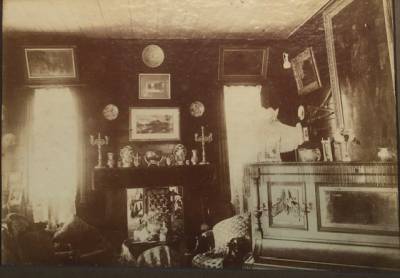 An undated photograph of the drawing room at Maroon.35) The player piano remains in the family, along with the large painting of TLM-P's father, two of the ornamental vases on the mantelpiece, and the three swords and battleaxe hanging on the wall.36) Sadly the homestead was destroyed by fire in 1947, some 27 years after Thomas B. M-P sold it.37)
An undated photograph of the drawing room at Maroon.35) The player piano remains in the family, along with the large painting of TLM-P's father, two of the ornamental vases on the mantelpiece, and the three swords and battleaxe hanging on the wall.36) Sadly the homestead was destroyed by fire in 1947, some 27 years after Thomas B. M-P sold it.37)
In the 1860s, with governments resuming land to break up into smaller farms, landowners such as TLM-P secured their (leased) land by buying it freehold. TLM-P had been 'freeholding [i.e. converting to freehold] parts of his run, including 2560 acres on 16 November 1868 alone. In 1876 he allowed what was left of the leasehold to lapse or revert to the government.' From then on, Maroon comprised entirely of freehold land.38) In his 1888 diary, TLM-P notes that 'the scrub around Mt Maroon is almost if not all taken up'.(Diary, 3 July)
There was a severe drought in southern Queensland in 1888 and Maroon suffered the usual rural vicissitudes. The major threat to Maroon's viability from the late nineteenth century was the spread of the exotic plant, prickly pear. It was not effectively contained until the mid-1920s with the introduction of cactoblastis.39)
TLM-P's love of art means that we have a number of paintings of and around Maroon. These two are by artist George Hart-Taylor40) There are other smaller paintings of the local area by Hart-Taylor in the M-P Papers in the Mitchell Library, Sydney.
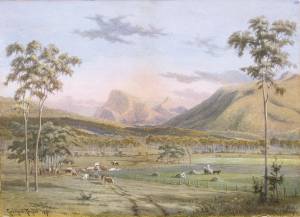
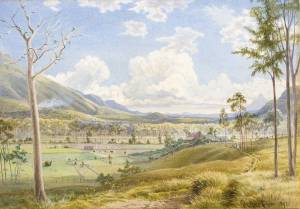
For more paintings of and around Maroon by George Hart-Taylor, click on landscapes.
For paintings and sketches of Maroon by unknown artists, click on sketches.
An undated photo of Maroon.41) 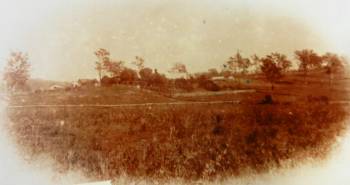
The following photos, courtesy of Deb Stenzel, are from an album of photos given to various members of parliament, business leaders, important visitors to Qld etc. One photo is of Mt Maroon; the other two are views of the Maroon homestead.
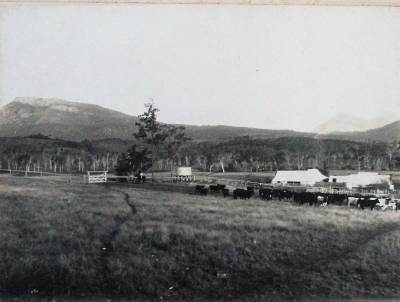
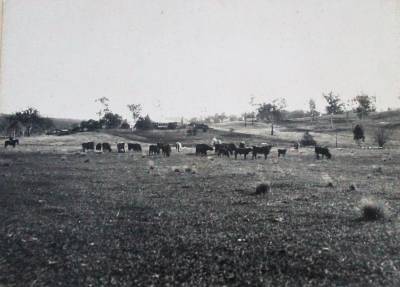
A copy of the 1914 subdivision sale poster from Collin Pfeffer, The Fassifern Story: a history of Boonah Shire and its surroundings42) 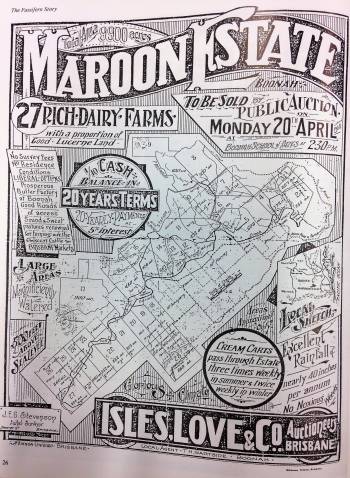
This photo from Collin Pfeffer, The Fassifern Story: a history of Boonah Shire and its surroundings43) is of Maroon c.1920, shortly after T.B. M-P sold the property. 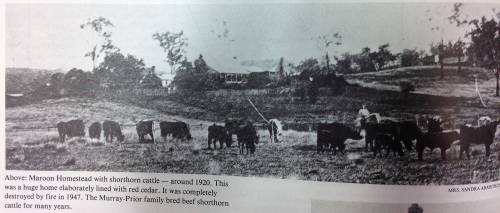
The following is an unidentified newspaper clipping reporting the fire. 44)
44)
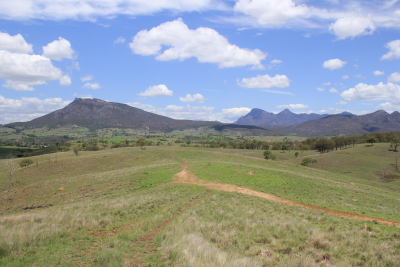 A photo by Deb Stenzel (taken in a good season) showing where the Maroon homestead used to be located (between where she stood to take the photo and the mountain range). Mt Maroon is on the left, and the two peaks of Mt Barney towards the centre. Mt Lindsay is peaking over the horizon between the two.45) For more photos by Deb Stenzel of the Maroon area, click on More Deb Stenzel photos
A photo by Deb Stenzel (taken in a good season) showing where the Maroon homestead used to be located (between where she stood to take the photo and the mountain range). Mt Maroon is on the left, and the two peaks of Mt Barney towards the centre. Mt Lindsay is peaking over the horizon between the two.45) For more photos by Deb Stenzel of the Maroon area, click on More Deb Stenzel photos
Mt Maroon in April 202546): 
For Maroon Station's ledger and accounts for 1864-71 and 1865-72 and 1878-88, respectively see MLMSS 3117/Box 8 and Box 9 and Box 10/Item 1.
Note: the Beaudesert Museum has numerous holdings relating to Maroon and the Murray-Prior family, see https://beaudesertmuseum.org.au
Land selections on and near Maroon
For an overview of the relevant Queensland land acts and government attempts to allocate land to squatters and smaller selectors, see Land_selection_in_Queensland. TLM-P and his eldest son Thomas de M. M-P (Tom) took advantage of the Crown Land Alienation Act 1868 (Qld) which allowed people to 'select' land to farm. Bill Kitson summarises, 'This Act allowed the Government to acquire half of the squatter's run either by resumption or voluntary surrender. This resumed half was then to be surveyed into blocks suitable for selectors looking for smaller agricultural farms. The run holder in return would receive a new lease on his half of the original run as well as other benefits. By this policy the Government was able to achieve their objectives of closer settlement with more people using the same area of land with the added benefit of an increase in rent.'47) The Act limited 'selections' of land to 640 acres and specified that the 'selector' had to have lived permanently on the land and farmed it, before its ownership was transferred.
Wives and dependent children were ineligible to select land, in what proved to be a somewhat fruitless exercise to prevent what became known as 'dummying', i.e. paying trusted family members or employees to select then to transfer the land when ownership was confirmed. Queensland historian Ross Fitzgerald concluded that the squatters regarded selectors as intruders and manipulated land regulations to keep the newcomers out:'many [squatters] resorted to “dummying” their runs (i.e., lodging land claims using the name of a family member or employee)… Most of the distinguished squatting families of the [Darling] Downs were involved'.48) TLM-P and Tom were no exception.
Angela Collyer49) lists Tom's four selections under the 1868 land act around Maroon:
| Lease 1164 | 1 October 1870 | Portion No. 9 | Melcombe parish | 320 acres |
| Lease 1594 | 5 August 1872 | Portion No. 12 | Melcombe parish | 1093 acres |
| Lease 1662 | 24 October 1872 | Portion No. 12 | Telemon parish | 3810 acres |
| Lease 1968 | 24 September 1873 | Portion No. 26 | Telemon parish | 705 acres |
A total of 5,928 acres (nearly 2,399 hectares). The Queenslander (9 November 1872) reported that Tom had selected at Telemon 80 acres of first class and 2,320 acres of second class pastoral land, then on 8 October 1873 made a conditional purchase of 640 acres of more 'second class' land. Andrew Darbyshire notes that Tom was probably 'dummying' for his father, to get around restrictions any one person could acquire property. Darbyshire also outlines Tom's purchases at Melcombe, Telemon and Mogill from March 1877 to January 1881. 50)
The 1868 land act was also relevant for Maroon's neighbouring property, Rathdowney. TLM-P purchased 2,560 acres on 16 November 1868, while on 3 January 1876 Tom selected the homestead block of 640 acres under this Act. After the Rathdowney homestead block was confirmed as his, Tom immediately transferred the land to his father. In January 1880, TLM-P acquired another 640 acres under the selection act. As a condition of acquiring the land, he had two witnesses swear that he had lived permanently there from the date of selection, February 1876. The witnesses were John Worrall and John Endersby, both stockmen in his employ.51) TLM-P's stockman John Worrall not only acted as a witness for Tom, but himself acted as the 'dummy'. Worrall selected 320 acres to the north of the Rathdowney property. Worrall's two witnesses (who swore that he had lived there permanently and thus was entitled to own the land), were John Endersby (the other of TLM-P's employees/witnesses) and Tom. In August 1879 when the selection process was completed, John Worrall immediately transferred the land to TLM-P.52)
While TLM-P joined his fellow squatters in circumventing the selection acts, he was sympathetic to the desire for people to own their own land. He was also aware that small holdings rarely provided a living for the selector. For more on this topic see THM-P's 1888 diary under TLM-P's Diaries. Collyer, in her thesis, argued that 'in the Boonah area there was little or no antagonism between squatters and selectors'. Her abstract states that:
Reasons for this included the fact that squatters around Boonah had not been aggressive in freeholding their runs as squatters elsewhere were reputed to have done. Thus there was more land available for Boonah selectors. Many of the latter were keen to take up the fertile scrubs, which had been useless to squatters since they contain no grass for grazing. Thus squatters and selectors did not always compete for the same land. The selectors were not dependent on squatters for seasonal work, nor were squatters dependent on selectors for labour, since Boonah squatters generally ran cattle not sheep by the 1870s. Besides, the pace of selection after the 1868 Alienation Act precluded squatters from monopolizing their runs before selectors arrived to take up their blocks. For all these reasons, closer settlement came to the Boonah area without provoking antagonism between squatters and selectors.53)
The area was transformed with the expansion of the railway - the first train left Dugandan Station in 1887.54).
Rathdowney
From 1865, the year after TLM-P acquired Maroon, TLM-P bought freehold land to the east of Maroon, on the northern bank of the Logan River. he bought 'freehold Por.10, Parish of Knapp, 642 acres from the crown for £248/11/3 ' on 3 january 1876.55) TLM-P combined his lots and named the new property Rathdowney after his ancestors' Irish estate.56) As noted above, acquiring Rathdowney involved Tom 'dummying' for his father and some dubious testimony from employees.
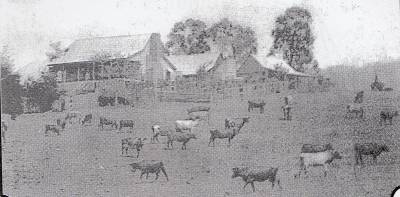 An undated photo of Rathdowney. The home has since been demolished and another rebuilt in its place. In September 1879, when it was inspected under the selection act, TLM-P was said to have lived in the weatherboard house with its shingle roof, a detached slab kitchen and separate slab house for workmen. There was also a garden.57) One source states that TLM-P put 'Palen (probably Head of the Logan) up for auction on 17th April, 1879, under the settled districts Pastoral Act or Lessee Act of 1876, but had no takers.'58)
An undated photo of Rathdowney. The home has since been demolished and another rebuilt in its place. In September 1879, when it was inspected under the selection act, TLM-P was said to have lived in the weatherboard house with its shingle roof, a detached slab kitchen and separate slab house for workmen. There was also a garden.57) One source states that TLM-P put 'Palen (probably Head of the Logan) up for auction on 17th April, 1879, under the settled districts Pastoral Act or Lessee Act of 1876, but had no takers.'58)
By 1880, the local council's rate book valued Rathdowney's buildings at £30.59) In November 1884, TLM-P sold Rathdowney to William Collins and Sons.60) Nora wrote to Rosa Praed on 3 November 1884, that it was sold cheaply but a necessity: 27/6 per acre for 18,000 freehold acres; £4 per head for 800 stores bullocks and £3 a head for 750 cows.'61) As Nora told Rosa Praed, if TLM-P were '20 years younger it would be madness to sell it yet the constant strain of hard labour is too much for him.'62) Rathdowney Station was subsequently subdivided and Rathdowney town developed there.63) The Rathdowney Visitor Information Centre and Historical Museum has wonderful volunteers and provides an excellent overview of the development of the area, including the tramway which operated from 1910 to 1944 - see https://rathdowney.org.au/.